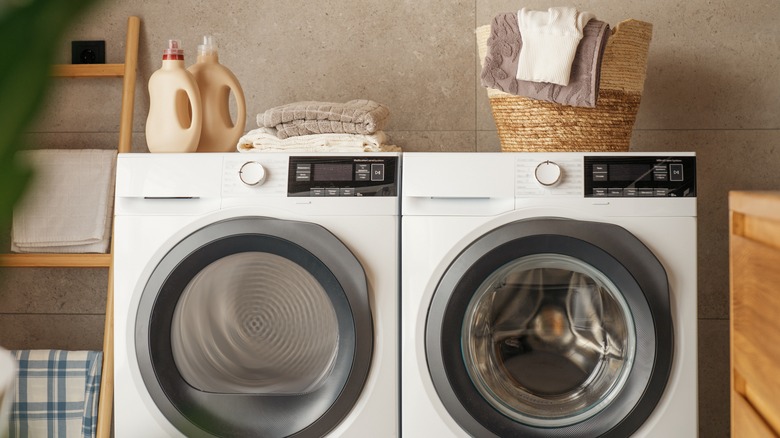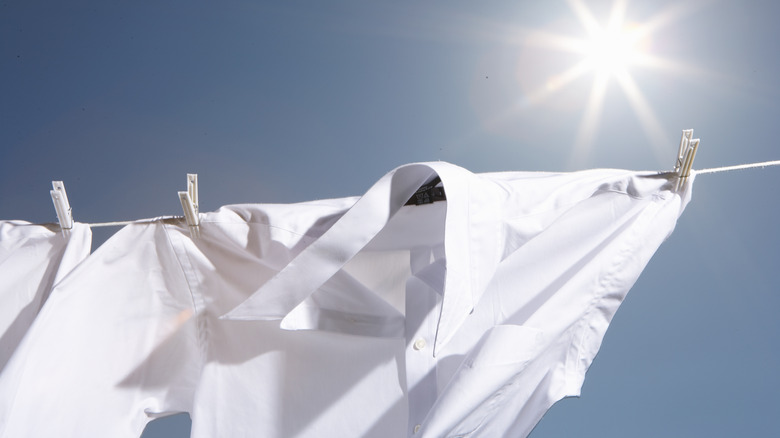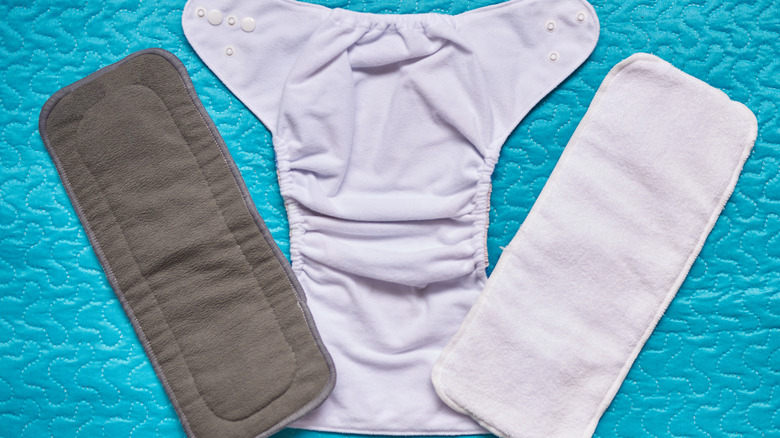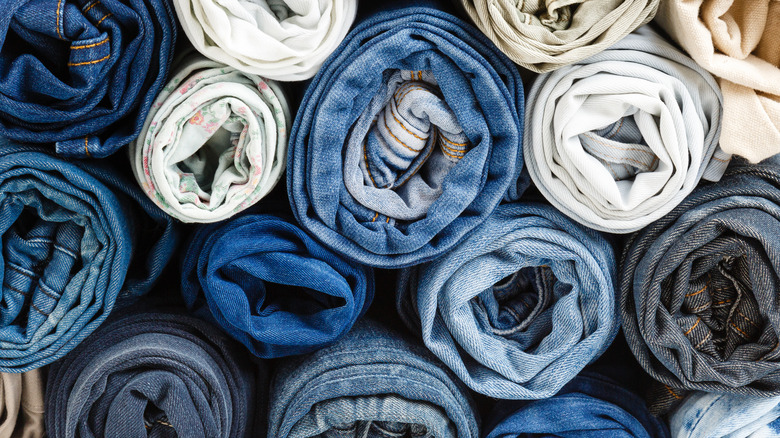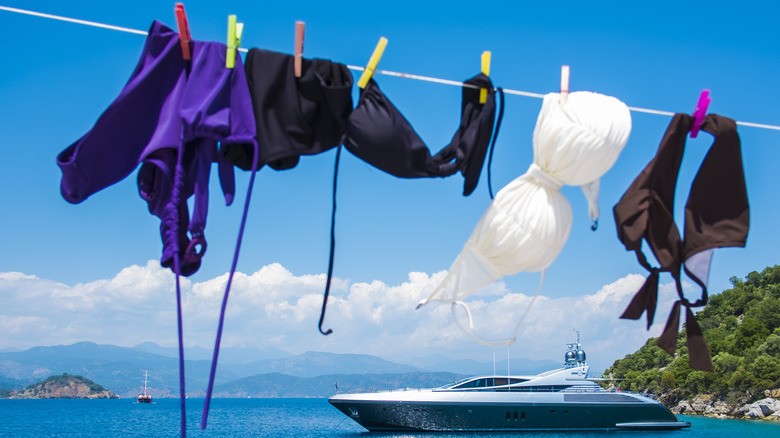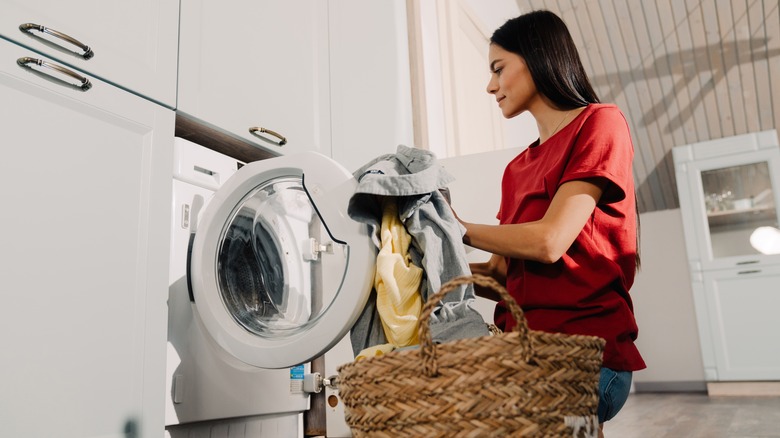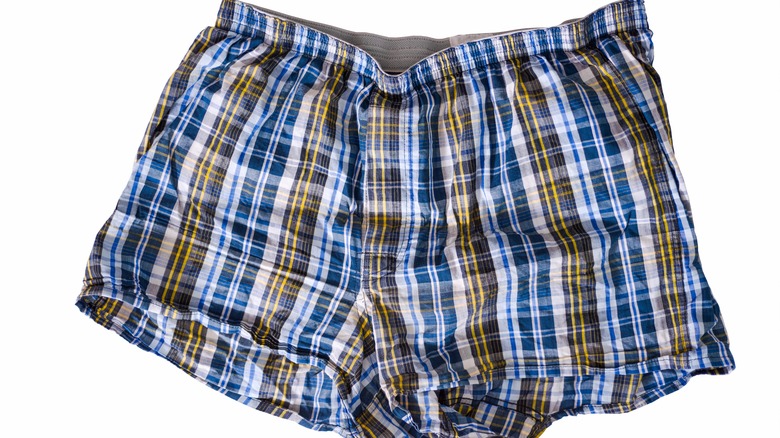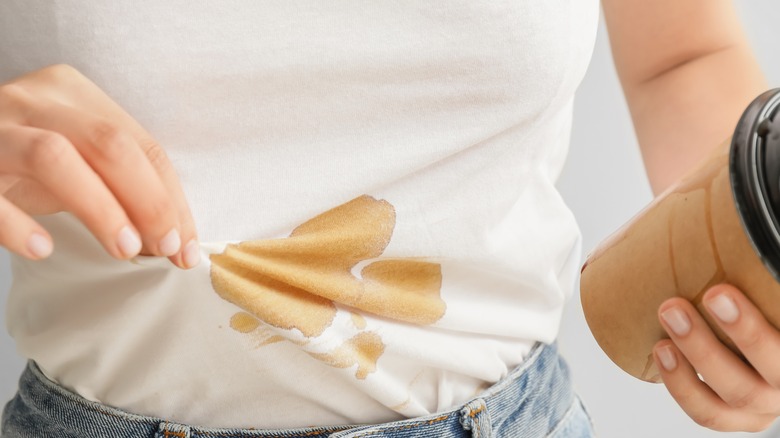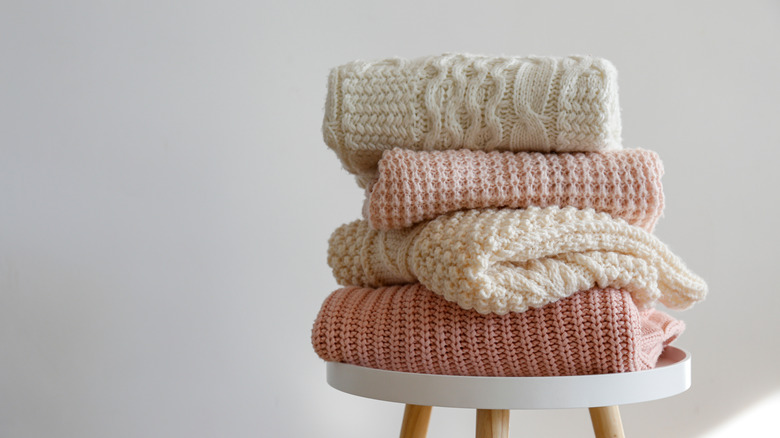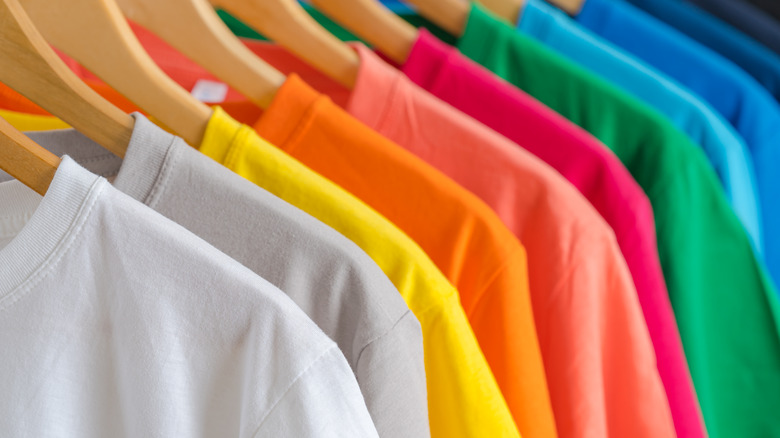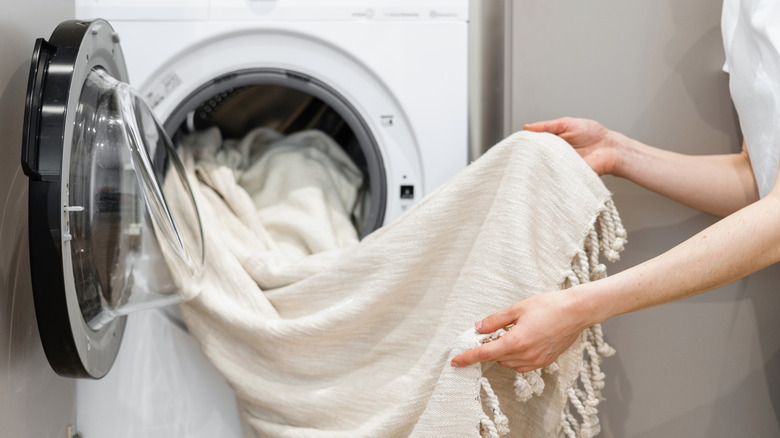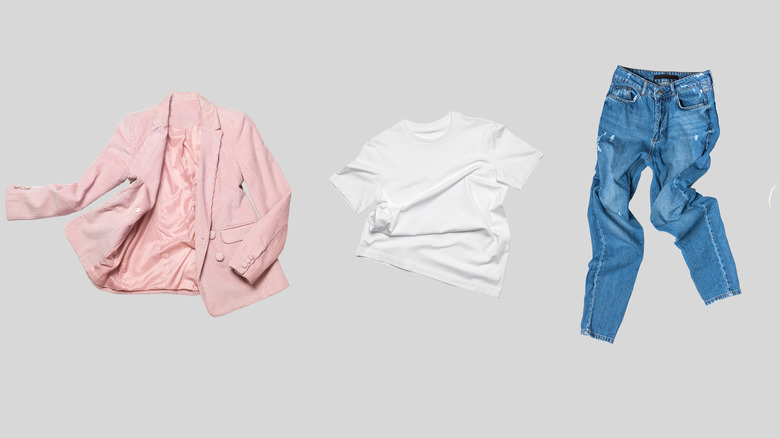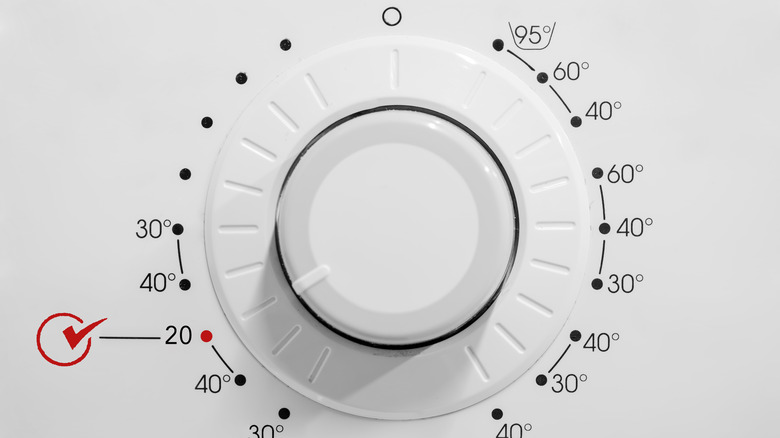The Ultimate Guide To Laundry Water Temperatures
Even if you're a laundry pro, it can be difficult to know which laundry temperature is best for each type of fabric. Sure, you know to tie up drawstrings before loading them, so they don't get tangled. You also do smaller loads of laundry more frequently because you know 1) your washing machine uses less water to accommodate smaller loads, and 2) you will actually fold all the laundry that comes out right away.
Yet even with all these skills under your belt, sometimes it's impossible not to get stuck. Picture this: You're standing in front of your washing machine with a delicate white blouse, a towel soaked in baby barf, and a knit sweater — how are you supposed to know what to do? Sure, the go-to advice is to check the care tag to learn how to wash each item. Yet sometimes, these tags are missing.
We might cut them out for comfort because, really, who likes an itchy tag rubbing against your neck all day? Or we might have bought something second-hand, or it never had a label on it anyway. Even if the tag is fully intact, your clothes might be so dirty that you must take a different route. This ultimate guide to laundry water temperatures is for everyone in a tight spot.
Use hot water for best results on most whites
It can be easy to take the easy route and wash all your clothes together. Even if you love tossing everything in the machine together, there is one type of clothing that you should always take your time to separate: whites. To keep your white clothing and linens glowing as they should, you must wash them differently than the rest of your clothes. However, the bad news is that you can't just toss all your different white clothing into the same load. Be sure to check the tags to ensure they aren't dry clean only or delicate, as these items should be cleaned separately and at different temperatures.
It's tempting to wash everything in colder water, especially now that there are lines of bleach and detergent made especially for chilly temperatures. However, remember that even the strongest bleach needs a little boost to do its job effectively. If you don't want your whites to be dingey or yellowed around the armpits, set your washing machine to "hot." Combined with the disinfecting power of the bleach, the high temperature will ensure your laundry is really clean.
Soiled clothes like sports uniforms and diapers should have hot water
If you are trying to get something that is especially dirty clean, you have to turn the temperature all the way up. This can be typical dirty things, like a baseball uniform caked in mud and grass stains or a dirty diaper soaked in urine. According to a study by the National Library of Medicine, the water should be nearly 40 degrees Celsius (roughly 104 Fahrenheit) to effectively remove germs from hospital scrubs after a shift. For similar removal of all potential biohazards like blood, urine, vomit, and sexual fluids, a higher temperature should also be used.
If you are concerned about high-temperature damaging delicate items like diapers or underwear, you don't need to be worried. Typically, the short nature of a wash cycle isn't enough sustained heat to cause long-term damage to our items. The only thing to be concerned about is sustained heat wearing out the elastic in items over time. You can avoid this by setting a shorter cycle, no matter how hot. Finally, remember that after washing items that are soiled, your washing machine needs to be cleaned as well, lest any germs cling to your clothing. Most washing machines have a sanitizing setting you can run before putting in your next load.
Use warm water for jeans
There is great cultural debate around whether or not you should wash your jeans at all. In fact, in 2011 Levi's began urging customers to put their jeans in the freezer between wears, instead of washing them. However, this doesn't do all that much for keeping your jeans clean. It just has the potential to contaminate the food in your freezer. "One might think that if the temperature drops well below the human body temperature they will not survive," Stephen Craig Cary, a University of Delaware expert on frozen microbes, told Smithsonian Magazine. "But actually many [germs] will. Many are preadapted to survive low temperatures."
It's kind of spooky to think about germs adapting to live longer to keep hanging out on our jeans, but the only real way to get rid of them is just to wash them. "The bacteria that would live on your jeans on the sloughed skin and the dirt nutrients than the jeans themselves, so detaching the sloughed skin could reduce the microbial load of your jeans," Julie Segre of the National Human Genome Research Institute told the magazine. To get rid of all this, you need to use warm water. It can eliminate germs and dead skin, ensuring they are fresh and ready to wear. If you are concerned about fading or shrinkage, don't pop them in the dryer, as that's where all the damage happens. Hang them out to dry instead.
Swimsuits should be washed with cold water
If you aren't washing your swimsuit after use, you are significantly shortening its lifespan. If you've found one you like, you need to ensure all the pool chemicals or salt water don't hang around at the end of the day. To preserve the life of your swimsuit, give it a quick rinse in cold water before you even dive in. "When you rinse first, the construction of filaments in the material will be filled with fresh water, and therefore will wick less of the chlorinated or salt water," Preeti Arya, an assistant professor at New York's Fashion Institute of Technology, told The New York Times.
When you're done swimming, it might be tempting to rinse your swimsuit in the shower along with yourself, or even worse, just let it dry on the back porch. However, this can lead to mildew growing and giving your suit a funky smell. Plus, if you don't wash off the sunscreen, sweat, and who knows what else, you'll ruin the fabric. It's best to be as gentle as possible, so set the cycle to cold and place your suit in a washing bag. This way, it will come out squeaky clean, and undamaged from the jostling of the machine.
Rinsing should be done with cold water
Sometimes you just need to rinse your clothes out. The most common reason would be you forget a load in the machine overnight and need to freshen it up before placing it in the dryer. However, you also might be working on getting the stain out of something and just need to get the prewash out of it before you decide what to do next. Whatever the reason, whenever you run the "rinse only" cycle on your washing machine, select the cold water setting.
Most energy used in a standard washing cycle comes from heating the water. Rinse cycles are shorter than full wash cycles, so the power to heat gallons of water for a quick spin would be a waste. By using cold water, you can ensure your energy bill doesn't spike while you wash your favorite shirt repeatedly while trying to get out the stain.
Wash your undergarments with hot water
Our undergarments are probably some of the dirtiest things we have to wash. Keeping them clean is essential since you don't want any bacteria or residue left behind. In fact, even if you wash your underwear after one day's use, there could still be about .1 grams of feces left behind. Sometimes, this is even up to 10 grams, which is shocking to consider, per the Journal of Infection.
Feeling a bit grossed out? Don't worry; the next time you have a load of delicates to take care of, simply crank up the heat. Dr. Charles Gerba, who conducted the study, told Reader's Digest that cold water "is designed to get clothing clean but not eliminate microorganisms." This means that the item might appear clean to the naked eye. It might even smell fresh when it comes out of the wash, but bacteria are still clinging to it. To remove things like sweat, fecal matter, blood, and the like, choose a temperature of "hot." This should be at least 140 degrees Fahrenheit or 60 degrees Celsius.
Visible stains should be treated with hot water (most of the time)
It's always such a bummer when you spill something on yourself. Whether you have an important meeting and attend wearing your breakfast or have to traipse through the mud after your pet, the cleanup is difficult. When you have the mission of removing a stain, all the instructions on the care tag nearly go out the window. You don't care about your shirt smelling fresh or being bacteria-free. You just need the dark blotch to disappear.
Different stains require different water temperatures. You typically can't go wrong with hot water for these kinds of stains: chocolate, coffee, wine, water-based ink, and oil-based stains (like salad dressing). However, use cold water if you bleed on yourself, drop a berry down your blouse, or spill a non-oil sauce like BBQ or tomato. Based on the makeup of these stains, hot water can set the stain. There is a lot of protein in them, so when the protein gets too warm, it becomes more and more stubborn to treat. No matter the temperature you use, remember that the longer you wait to wash the stain, the less likely you will be able to get it out.
Knit sweaters and blankets are best washed with cold water
Knit items are delicate items masquerading as heavy-duty fabrics. This is especially true if the items are handmade. In this instance, it's always better to handwash the baby blanket your grandmother knitted for you in room-temperature water with a mild detergent. However, not all of us have time for this level of care. We need to sanitize our sweaters, mittens, and beanies without spending hours looking after them. If you plan to use a washing machine for anything knitted, set the temperature to cold.
Warmer water can ensure things get clean, sure. But it can also pull the fibers apart, causing a misshapen sweater. Depending on the quality of the wool used, higher temperatures can also pull the color out from the dye significantly quicker than cooler counterparts. In addition to cold water, be sure to set your machine to its delicate cycle. It's worth looking at the manufacturer's handbook before starting the load to ensure that the delicate cycle stays chilly the entire time and doesn't use different temperatures for different parts of the rinse.
Bright clothing is best washed with cold water
If you like to dress in lots of colors, you will want to wash your bold clothing in chilly water. The reason bright clothing starts to look dingy is that the dye starts fading from the fabric. Throughout use, the friction from everyday wear and the heat from washing start to wear things down. Using cold water can slow down this process. It doesn't mean it will never happen, as the dye will separate eventually. However, you will get many more wears out of your favorite things.
In addition to washing your brightly colored clothes in colder water, consider turning them inside out as well. This works alongside the temperature to preserve the freshness of the item. The key is ensuring interior fibers are more exposed to the brunt of the friction from the washing machine and the temperature of the water.
Disinfect bedding with hot water
We are really hard on our sheets. You might not realize it, but you are shedding every night as you sleep. You shed hair, skin sloughs off from all parts of you, and you sweat as you toss and turn. We need to change our sheets way more often than we do. The most sanitary option is to swap out your sheets once a week, but two weeks will do in a pinch if it works better for your schedule. That's a far cry from leaving your sheets on for an entire semester back in our college days ... which we are sure plenty of us are guilty of.
To make sure your sheets, blankets, and pillowcases are getting clean in between uses, you need to disinfect your bedding with hot water in the wash. High temperatures of 40 to 60 degrees Celsius (roughly 104 to 140 Fahrenheit) are ideal. This way, all the bodily fluids, lotions, food crumbs, and, yes, even microscopic dust mites are eliminated. In addition, if you are sick, be sure to change your sheets as you begin to heal, as germs can cling to the fabric if not washed in high temperatures, and you might reinfect yourself.
Everyday cotton should be washed with cold water
Cotton is one of the most common fabrics for clothing, but also the most tricky when it comes to caring for it. Your favorite shirt, pair of pants, or even blanket might be 100% cotton, but if you wash it incorrectly one time, it might be ruined. Cotton is known to shrink, wrinkle up, and become incredibly faded and misshapen as it comes through the laundry. All cotton will shrink, you can't fight that. The real battle is about how much shrinkage happens. This is what you do have control over.
When clothes are made, the cotton material is stretched and shaped. If you apply any heat, it causes the material to relax, hence the shrinkage. Imagine stretching a piece of fabric to its max, then letting it go. It scrunches back up. This is what happens to your clothes. To avoid this, always wash cotton clothing in the cold water setting. You can also turn clothes inside out to prevent wear and tear and avoid tumble drying.
Use cold water for energy efficiency
Using cold water to do your everyday laundry is great for both your wallet and the planet. According to Cold Water Saves, over 90% of the energy a washing machine uses is to heat the water to the desired temperature. If you begin using the cold settings, you will see an immediate reduction in the amount of power you consume daily. This translates to about $200 less on energy bills annually for most folks. In addition, the overall number of metric tons of greenhouse gases prevented from being released into our atmosphere by cold water washing is in the millions.
Advocates of cold water washing highlight that the modern technology in most washing machines doesn't require hot water to strip away the stains and smells of everyday use. Unless you are washing clothes by hand, you don't need heat, as the vigor of the cycle takes care of that for you. Overall, cold water washing is an easy way to save a little bit of money on bills each year, while knowing you are also doing your part for the environment.
